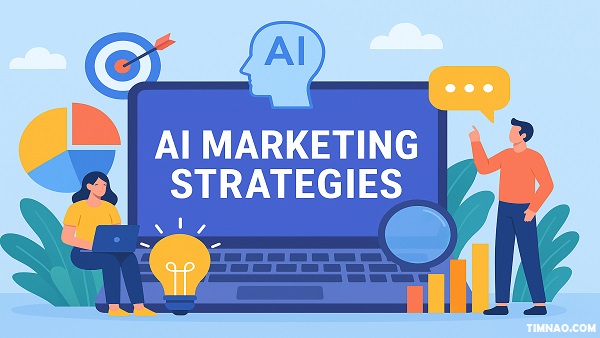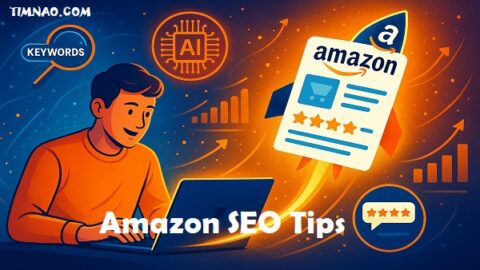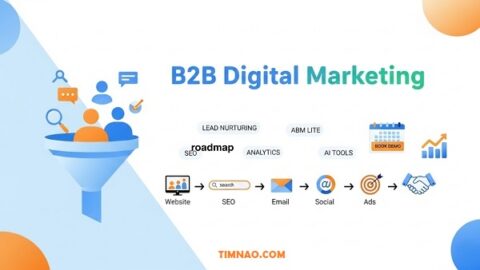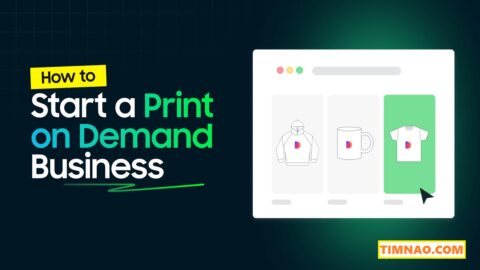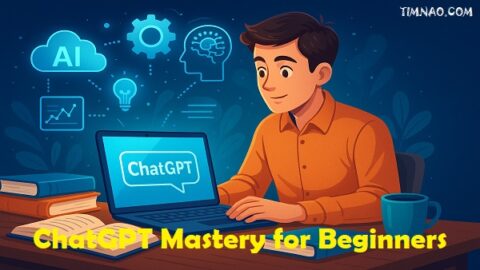🔥 Unlock Explosive Growth with Smart AI Marketing (Beginner-Friendly Guide) 🤖
AI marketing strategies are transforming how businesses attract, engage, and convert customers in 2025.
If you’re still relying on traditional digital campaigns, you’re missing out on a smarter, faster, and more profitable way to grow. With tools like hyper-personalized ads, predictive analytics, and programmatic bidding, AI makes it easier than ever to target the right audience with the right message at the right time.
And the best part? You don’t need to be a tech expert to take advantage of this marketing revolution.
In this beginner-friendly guide, we’ll walk you through the most powerful AI marketing strategies being used today—and how you can apply them to scale your business like a pro.
📚 Table of Contents
- 🤖 The Rise of Smart Marketing
- 🎯 Personalization 2.0: Hyper-Personalized Ads Powered by AI
- 💡 Programmatic Advertising & Real-Time Bidding: Smarter Ad Spend
- 🔄 Cross-Platform Retargeting: Consistency That Converts
- 🧬 Dynamic Creative Optimization: Personalized Ads at Scale
- 📺 Addressable TV & AR: Merging Real-World and Digital Experiences
- 🧠 Behavioral Targeting & Predictive Analytics: Reading Intent in Real Time
- 🧰 Essential Tools for AI-Powered Marketing Success
- 🚧 Pitfalls to Avoid: Privacy, Overload & Integration
- 🏁 Final Thoughts: Building a Future-Proof Marketing Strategy
- ❓ FAQs: Beginner Questions About Advanced Marketing Answered
🤖 The Rise of Smart Marketing
If you’re marketing in 2025 without AI, you’re marketing blind.
Traditional tactics—like placing banner ads and hoping for clicks—are rapidly losing effectiveness. Consumers today demand relevance, speed, and personalization. That’s where AI marketing strategies shine.
Modern tools like Google’s Performance Max, Meta Advantage+, and platforms like AdRoll use machine learning to analyze user data, predict behavior, and automatically adjust your campaigns in real time.
What does this mean for you?
- Faster results with less guesswork
- Higher conversion rates through smarter targeting
- Less wasted ad spend on the wrong audiences
Whether you’re a solo entrepreneur or growing a small business, this guide will walk you through the top AI-driven marketing tactics to start using right now.
🎯 Personalization 2.0: Hyper-Personalized Ads Powered by AI
Imagine showing each customer exactly what they want—before they even know they want it.
That’s what hyper-personalized advertising delivers. Powered by AI, these ads dynamically change based on a person’s behavior, location, browsing history, and more.
🔧 How It Works:
- A visitor browses your online shop.
- AI tracks their behavior (e.g., clicked products, abandoned cart).
- Later, they see ads showing those exact products, possibly with a custom discount or message.
- The ad might change depending on time of day, weather, or device used.
✅ Real-World Example:
Spotify Wrapped is a masterclass in personalization. Each user receives a unique report on their listening habits. This has become a viral event—proving how powerful custom content can be.
🛠 Tools to Get Started:
Beginner Tip: Start by segmenting your audience using basic criteria like age, gender, or device. Then use dynamic templates to customize ad content for each group.
💡 Programmatic Advertising & Real-Time Bidding: Smarter Ad Spend
Let’s say you want your ad to reach 25-year-old sneaker fans browsing fashion blogs—but only if they live in New York and have clicked a product in the last week.
This level of precision is possible with programmatic advertising and Real-Time Bidding (RTB).
🧠 What It Means:
- Programmatic advertising automates buying/selling ads using AI.
- RTB means advertisers bid on ad placements in real time—in milliseconds—based on user profiles.
✅ Why It Works:
- Maximized ROI: Only pay for impressions that matter.
- Reduced waste: Avoid showing ads to users who aren’t your target.
- Faster campaigns: AI handles placement and optimization automatically.
🛠 Tools to Try:
Beginner Tip: Use “lookalike audiences” based on your best customers. Let the platform find similar users to target—at scale.
🔄 Cross-Platform Retargeting: Consistency That Converts
Ever noticed how after checking out a pair of sneakers online, you suddenly start seeing them everywhere?
That’s cross-platform retargeting in action.
It keeps your brand top-of-mind by following users across devices and platforms—desktop, mobile, social media, and even smart TVs.
🔄 Benefits:
- Better brand recall: Show consistent messages across every touchpoint.
- Higher conversion rates: Remind people of what they left behind.
- Smarter segmentation: Target cart abandoners, page visitors, or even people who watched your videos.
🛠 Tools You Can Use:
- Meta Pixel (Facebook & Instagram)
- Google Ads Remarketing
- LinkedIn Matched Audiences
Pro Tip: Use frequency caps to avoid overwhelming users. Retarget strategically—not annoyingly.
🧬 Dynamic Creative Optimization: Personalized Ads at Scale
Imagine being able to instantly generate hundreds—or even thousands—of ad variations tailored to different audience segments, all without manually creating each one.
That’s the magic of Dynamic Creative Optimization (DCO). With DCO, AI and automation come together to deliver personalized advertising at scale—no matter how big your audience.
🧠 What Is DCO?
Dynamic Creative Optimization is an advanced AI technique that automatically assembles ad elements (images, headlines, CTAs, etc.) in real-time based on user data.
Every user sees a slightly different ad that reflects their preferences, location, behavior, or device.
For example, two users visiting the same travel site might both see ads for flights—but one sees beach vacations in Thailand, while another sees snowboarding deals in Canada, all based on past behavior.
💼 Key Components of DCO:
- DMP (Data Management Platform): Collects and segments audience data.
- CMP (Creative Management Platform): Stores your images, videos, copy, and brand assets.
- Ad Server: Assembles and delivers the right creative variation to the right user.
✅ Why DCO Works:
- Massive Personalization: You can deliver 10,000 ad versions from one smart template.
- Real-Time Adaptation: Ads adapt instantly to user context—weather, location, time of day, or even device type.
- Higher Engagement: Tailored ads outperform generic ones—every time.
🛠 Tools to Explore:
Beginner Tip: Start simple. Create a few modular ad assets—like interchangeable product images and headlines—and let your platform handle the combinations.
🔍 Example Use Case: E-Commerce Store
A fashion brand running a DCO campaign might:
- Show winter coats to users in colder regions, and swimsuits to users in warmer ones.
- Adapt the call-to-action based on whether someone’s on mobile (“Tap to Shop”) or desktop (“Explore the Collection”).
- Serve localized promotions (“Free shipping to New York!”).
This level of personalization—at scale—is nearly impossible without DCO.
📺 Addressable TV & AR: Merging Real-World and Digital Experiences
Television isn’t dead. It’s evolving.
With Addressable TV, brands can now deliver different ads to different households—even if they’re watching the same show.
And when paired with Augmented Reality (AR), advertisers can blur the lines between digital and physical experiences like never before.
📺 Addressable TV: Personalized Ads on the Big Screen
Addressable TV advertising lets brands target individual households based on data like demographics, interests, and location. It’s the TV version of hyper-targeted digital ads.
🔧 How It Works:
- Viewers watch a live show or on-demand content.
- The ad server identifies the household and inserts a relevant ad based on their profile.
- Two neighbors watching the same show may see completely different ads.
This is all made possible through smart TVs and set-top boxes from providers like Comcast, Dish, and Roku.
✅ Key Benefits of Addressable TV:
- Better Targeting: Ads are based on household-level data.
- Reduced Waste: No more spending on audiences that don’t convert.
- Measurable ROI: Track view-through rates and engagement just like online ads.
🛠 Tools to Get Started:
Beginner Tip: Repurpose your existing video content. Then add targeting layers with addressable platforms.
🧠 Augmented Reality (AR): Immersive & Interactive Ads
AR advertising allows users to interact with digital elements overlaid on the real world via smartphones or AR glasses. This tech is more than a gimmick—it’s a powerful tool to boost engagement and conversions.
🌟 Benefits of AR in Marketing:
- Virtual Try-Ons: Let customers preview makeup, clothing, or furniture in real-time.
- Interactive Demos: Show product features in 3D without needing a physical sample.
- Stronger Brand Recall: Interactive content is more memorable than static ads.
✅ Real-World AR Campaigns:
- L’Oréal’s AR Beauty App lets users try on makeup virtually.
- IKEA Place helps customers see how furniture fits in their room.
- Pepsi’s AR Bus Stop in London became a viral hit, blending entertainment with surprise marketing.
🛠 AR Tools to Use:
Beginner Tip: Try adding an AR layer to a print ad or packaging. QR codes can launch an immersive experience with just one scan.
🔄 Bringing It All Together
Imagine launching a campaign where:
- A family watches your addressable TV ad about your new sneaker drop.
- They scan a QR code and enter an AR experience where they can virtually try on the shoes.
- Later, they’re retargeted with a personalized DCO ad offering a limited-time discount.
This is omnichannel, immersive marketing—and it’s more accessible than ever.
🧠 Behavioral Targeting & Predictive Analytics: Reading Intent in Real Time
Modern marketing isn’t just about reaching audiences—it’s about understanding them.
With behavioral targeting and predictive analytics, you can analyze what users do online and predict what they’ll do next—allowing you to deliver the perfect message at the perfect time.
This is where marketing starts to feel like mind reading. But it’s not magic—it’s data + AI.
📊 What Is Behavioral Targeting?
Behavioral targeting is the practice of showing ads or content to users based on their previous actions, such as:
- Pages visited
- Products viewed
- Searches made
- Emails clicked
- Social media interactions
Instead of relying on static demographics (like age or gender), behavioral targeting focuses on what really matters: user intent.
For example, a visitor who checks out three different running shoes is clearly in-market. Behavioral targeting helps you turn that insight into action—like serving a discount or reminder ad at just the right time.
🔮 What Is Predictive Analytics?
Predictive analytics goes one step further: it uses machine learning to anticipate a user’s next move based on patterns.
Let’s say your data shows that customers who read your pricing page and then watch a video have a 65% chance of converting. AI can identify users following that path in real time—and trigger personalized CTAs, offers, or retargeting sequences before they bounce.
✅ Real-Life Use Cases:
- E-commerce: Predict when a shopper is likely to abandon their cart, and proactively offer a discount.
- SaaS: Identify leads who are likely to churn based on login frequency or feature usage, and send re-engagement emails.
- Streaming Platforms: Recommend shows based on user binge patterns—just like Netflix does.
🛠 Tools That Enable Behavioral Targeting & Predictive Analytics:
- Segment: User data platform that helps track, unify, and route behavioral data.
- Google Analytics 4: Provides detailed behavioral insights.
- Salesforce Einstein: AI layer that enables predictive customer behavior modeling.
- Klaviyo: Email and SMS tool with predictive features for e-commerce.
- Pendo: Great for SaaS platforms wanting to track in-app behavior and user intent.
💡 Beginner Tips:
- Start by identifying micro-conversions (e.g., video views, downloads, time on site) and build audiences around them.
- Use behavioral email triggers like “abandoned cart,” “browsing reminder,” or “price drop alert.”
- Layer behavioral signals with demographic filters for precise targeting (e.g., women who viewed yoga pants + live in L.A.).
⚠️ Challenges to Watch For:
- Data Overload: Too much data without a strategy can lead to analysis paralysis. Focus on meaningful metrics.
- Privacy Regulations: Always get consent and comply with GDPR/CCPA when collecting behavioral data.
- Misinterpretation: Not every action equals purchase intent. Use AI models to separate curiosity from conversion.
Behavioral targeting and predictive analytics are at the heart of intent-driven marketing. They don’t just help you follow users—they help you lead them toward action.
🧰 Essential Tools for AI-Powered Marketing Success
To implement all these AI-driven strategies, you need the right tools. The good news? Many of the most powerful platforms today are beginner-friendly and plug-and-play.
Below is a curated toolbox of essential platforms every digital marketer should consider when diving into AI marketing.
💼 Ad & Campaign Automation
- Google Performance Max
Automatically optimizes ads across Google Search, YouTube, Display, Gmail & more. Great for hands-off campaign management. - Meta Advantage+
AI-powered solution for Facebook and Instagram that simplifies and improves ad targeting and delivery. - AdRoll
Perfect for retargeting and prospecting with AI optimization for smaller businesses.
🧠 Behavioral Data & Customer Segmentation
- Segment
Collects and unifies customer data from every touchpoint, making behavioral targeting much easier. - HubSpot
Offers powerful segmentation and automation features for inbound marketing and email. - MoEngage
Ideal for mobile-first businesses that need AI-driven engagement and user behavior insights.
🔍 Predictive Analytics & AI Insights
- Salesforce Einstein
AI layer for sales, marketing, and service insights—ideal for enterprises. - Pega
Combines AI decision-making with marketing automation for real-time personalization. - Zoho CRM Plus
Offers AI-powered predictive scoring, automation, and suggestions for marketers.
🎨 Dynamic Ad Creatives & Content Generation
- Canva Magic Write
AI content generator for visuals and short-form copy—perfect for beginners. - Copy.ai
Generate headlines, product descriptions, and CTAs in seconds using AI. - Bannerflow
Lets you build, scale, and optimize dynamic display ads with DCO capabilities.
💌 Email & Personalization Platforms
- Klaviyo
E-commerce favorite for AI-powered email and SMS marketing, plus predictive analytics. - MailerLite
Budget-friendly option with automation, segmentation, and AI-enhanced recommendations. - ActiveCampaign
Offers behavioral triggers and customer journey mapping backed by AI.
📈 Analytics, Testing & Optimization
- Google Optimize (replaced by GA4 Experiments)
Run A/B and multivariate tests to see what creatives or CTAs work best. - Crazy Egg
Visual heatmaps and scroll tracking to understand user behavior. - Hotjar
Excellent for tracking user interactions, surveys, and session replays.
📌 Quick-Start Stack for Beginners:
If you’re just getting started and want a low-friction setup:
- Email + Automation: Klaviyo or MailerLite
- Ad Management: Google Performance Max
- Data & Tracking: Segment or GA4
- Visual Content: Canva + Copy.ai
- Behavior Insights: Hotjar or Crazy Egg
Start with these, then expand your stack as your needs grow.
🚧 Pitfalls to Avoid: Privacy, Overload & Integration
AI-powered marketing offers incredible possibilities—but it’s not without risks. As you implement advanced strategies, there are a few common traps that beginners (and even pros) can fall into.
Let’s explore the biggest marketing landmines and how to sidestep them.
🕵️♀️ Privacy Pitfalls: Don’t Cross the Line
Data is the fuel of AI—but collecting and using it comes with serious responsibility.
In the wake of privacy laws like GDPR, CCPA, and emerging global frameworks, marketers must walk a tightrope between personalization and privacy.
🔐 Key Mistakes to Avoid:
- Failing to ask for explicit consent before tracking behavior.
- Not disclosing how user data is collected and used.
- Storing data longer than necessary.
✅ Best Practices:
- Use clear opt-in language for cookies and email subscriptions.
- Offer easy opt-out options.
- Work with GDPR-compliant tools like Cookiebot or Termly.
Remember: Privacy isn’t just a legal issue—it’s a trust issue. Respect data, and users will respect your brand.
🌊 Data Overload: Don’t Drown in the Numbers
More tools. More metrics. More dashboards. It’s easy to get overwhelmed.
AI marketing platforms generate tons of data—but not all data is useful.
😵💫 Signs of Data Overload:
- Your team spends more time reading reports than making decisions.
- You’re tracking 100 KPIs but acting on none.
- You have no clear benchmarks for success.
✅ What to Do Instead:
- Choose 3–5 actionable KPIs aligned with your goals (e.g., CPA, ROAS, LTV).
- Automate reports with tools like Google Looker Studio.
- Focus on trends over vanity metrics.
The goal isn’t more data—it’s better decisions.
🔌 Poor Integration: When Tools Don’t Talk
Your email platform says one thing, your CRM says another, and your analytics tool is a mess. Sound familiar?
Poor tech stack integration can sabotage even the smartest strategies.
🚫 Common Issues:
- Duplicate customer profiles
- Inconsistent campaign tracking
- Inability to automate personalization
✅ Solutions:
- Use middleware platforms like Zapier or Make to sync tools.
- Choose marketing suites that natively integrate, like HubSpot or ActiveCampaign.
- Perform regular data hygiene audits to clean up contacts and tags.
Avoiding these pitfalls helps you build a sustainable, compliant, and scalable AI marketing strategy. Don’t let avoidable mistakes block your growth.
🏁 Final Thoughts: Building a Future-Proof Marketing Strategy
AI marketing isn’t a fad—it’s the new foundation of digital growth. And the brands that adopt it early (and smartly) will dominate tomorrow’s marketplaces.
But here’s the key: it’s not about chasing every shiny new tool. It’s about building a strategy that’s:
✅ Customer-centric
✅ Data-informed
✅ Automation-powered
✅ Ethically aligned
Whether you’re running an online store, a coaching business, or managing campaigns for clients, this guide gives you a blueprint to compete and win in the AI age—even as a beginner.
🚀 Quick Action Plan Recap
- Start with Personalization: Use behavioral triggers and segmentation to tailor your messaging.
- Experiment with Programmatic Ads: Begin with small budgets and learn how automated bidding works.
- Test DCO & Retargeting: Build modular ad creatives and retarget cart abandoners.
- Explore New Channels: Try Addressable TV or AR campaigns on a test basis.
- Use AI-Powered Tools: Start with Google Performance Max, Canva, and Klaviyo for quick wins.
- Measure & Optimize: Focus on metrics that tie back to revenue—like LTV, ROAS, and churn rate.
AI won’t replace marketers. But marketers who use AI will replace those who don’t.
Start now, start small, and grow smart.
❓ FAQs: Beginner Questions About Advanced Marketing Answered
Q1. Do I need to be a data scientist to use AI marketing?
Not at all. Most modern platforms like Google Ads, Meta, and Klaviyo have user-friendly interfaces with AI features baked in. You just need to know what outcomes you want—AI does the rest.
Q2. What’s the difference between automation and AI in marketing?
- Automation follows rules you set (e.g., send an email after a form is submitted).
- AI learns and adapts, making decisions based on user behavior and data patterns.
Use both together for maximum impact.
Q3. Is AI marketing expensive to implement?
Not necessarily. Many tools offer free plans or affordable entry points, and the ROI often justifies the cost. Start with free trials, scale as you grow.
Q4. What are the top 3 AI tools I should start with as a beginner?
- Google Performance Max: For automated cross-channel ad campaigns.
- Klaviyo: For predictive email/SMS campaigns.
- Hotjar: For visualizing user behavior on your site.
Q5. Can AI help with content creation too?
Absolutely. Tools like Copy.ai, Jasper, and Canva Magic Write can generate blog posts, product descriptions, headlines, and visuals in minutes.
Q6. What’s one thing I should do today to get started?
✅ Audit your current marketing tools and choose one area to enhance with AI—whether it’s ads, emails, or analytics.
Start with a single use case, prove the results, and expand from there.
🎉 Congratulations! You’ve Just Future-Proofed Your Marketing
Whether you’re just starting out or looking to scale your efforts, AI-powered marketing strategies can give you the clarity, efficiency, and results you need.
Welcome to the new era of smarter, faster, and more personalized marketing.
You’re ready. Let’s grow. 🚀

